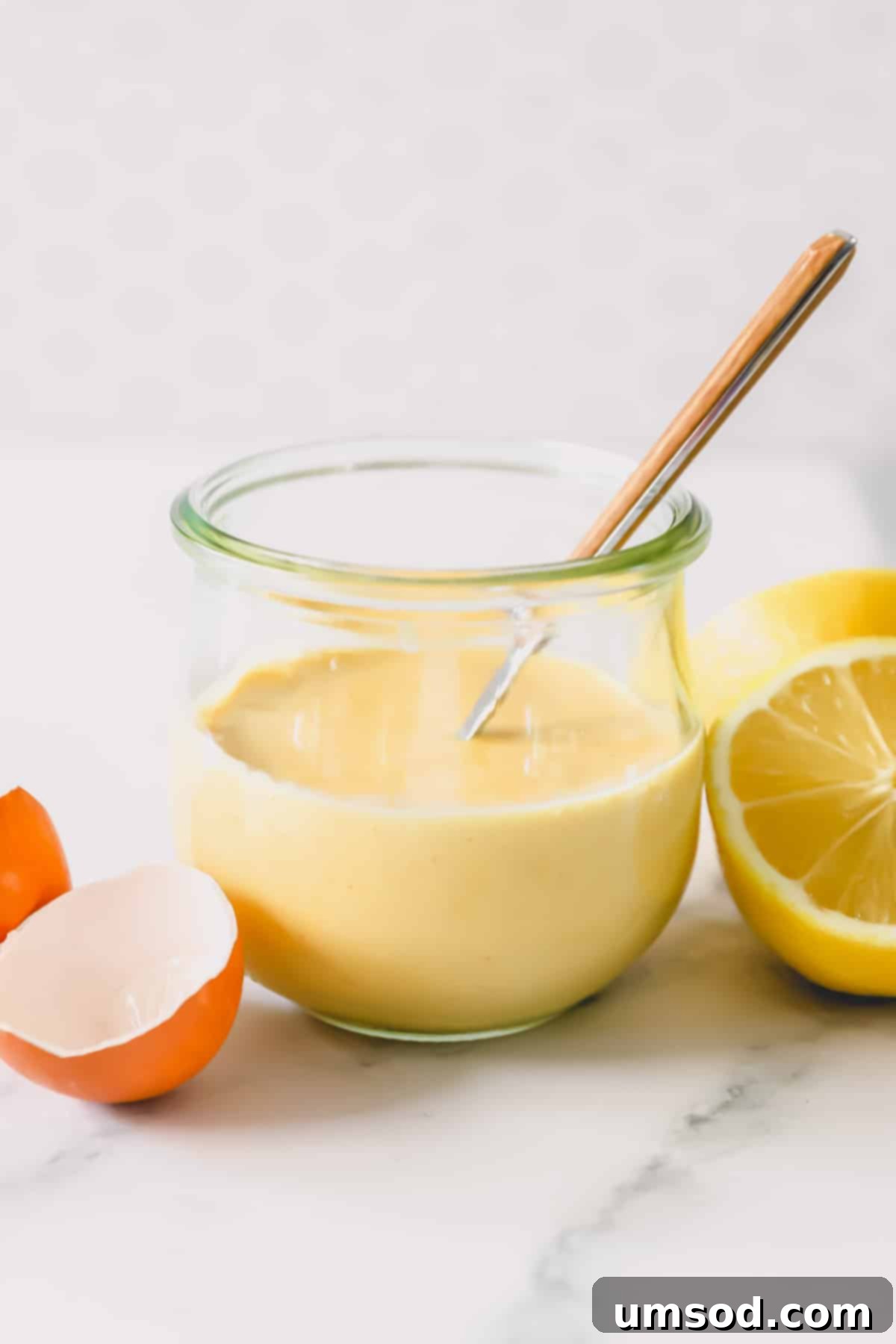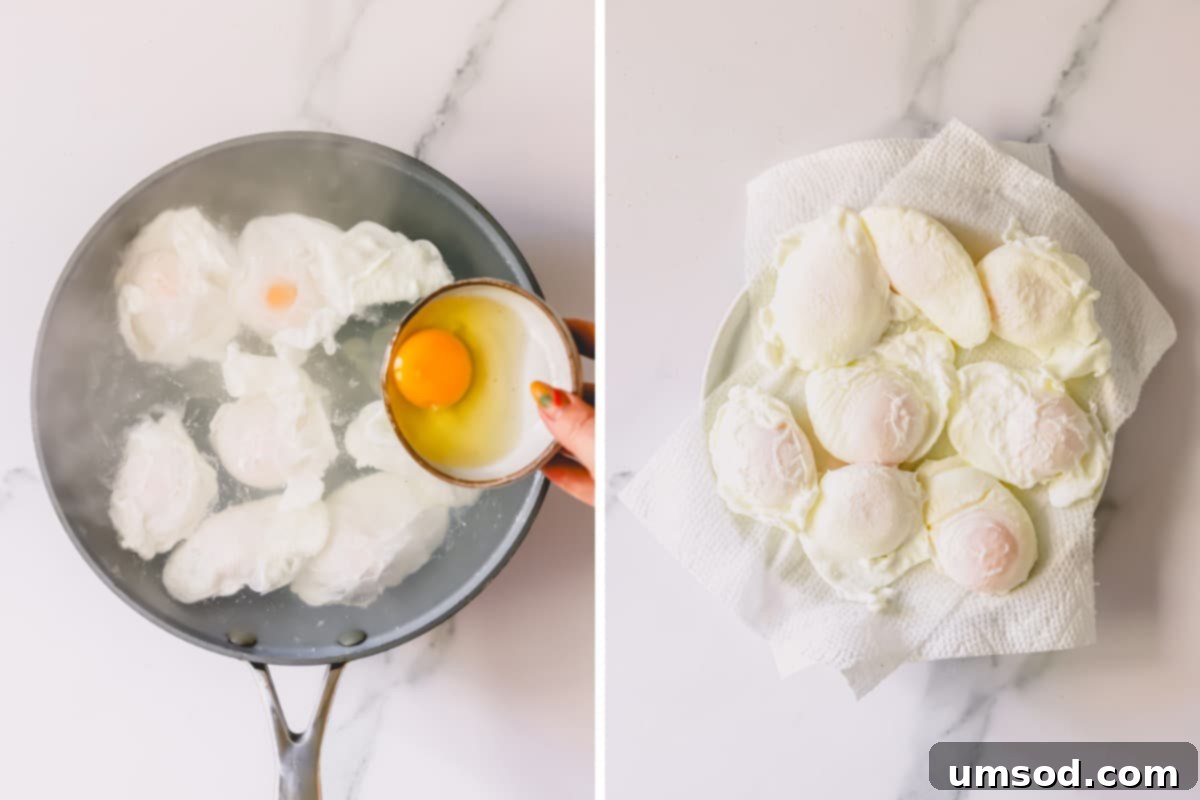Elevate your brunch experience with this exquisite Eggs Benedict recipe, a timeless classic that promises to impress. Whether you’re hosting a special occasion, enjoying a leisurely Sunday, or simply craving a restaurant-quality breakfast at home, this dish is your perfect companion. Our signature element is a lusciously rich, homemade Hollandaise sauce, effortlessly prepared in a blender – no tedious whisking required – delivering that flawless, buttery finish every time. Paired with perfectly poached eggs and toasted English muffins, it’s a culinary masterpiece within reach.

Pin this recipe now to find it later
Pin It
Why You’ll Adore This Eggs Benedict Recipe
For as long as I can remember, Eggs Benedict has been my ultimate brunch indulgence. There’s something undeniably captivating about the combination of tender, perfectly poached eggs nestled atop a crisp English muffin, generously draped in a rich, velvety Hollandaise sauce. Each forkful is a symphony of textures and flavors – a truly heavenly experience!
This recipe demystifies the art of making Eggs Benedict at home, proving that this gourmet dish is surprisingly accessible. Forget intimidating culinary techniques; we’re breaking it down into simple, foolproof steps. Here’s what makes this recipe a must-try:
- Effortless Elegance: Learn to master Eggs Benedict at home with remarkable ease. You’ll be surprised at how simple it is to create such an elegant dish.
- Perfect Poaching Every Time: Discover the secret to consistently achieving perfectly poached eggs with firm whites and runny yolks, thanks to a clever ramekin trick and a splash of white vinegar.
- Fail-Proof Blender Hollandaise: Say goodbye to arm-aching whisking! Our blender method ensures a smooth, stable, and utterly delicious Hollandaise sauce in minutes, perfect for utilizing those leftover egg yolks.
- Impressive & Delicious: This classic breakfast recipe consistently garners rave reviews. Follow our straightforward guide, and you’re guaranteed to master it on your very first attempt, delighting everyone at your table.
This classic breakfast recipe is an absolute crowd-pleaser and a staple for any discerning home cook. Prepare to impress with your newfound culinary skills!

Essential Ingredients for Perfect Eggs Benedict
Crafting the perfect Eggs Benedict begins with understanding the role each ingredient plays. Here’s a breakdown of what you’ll need and why it matters:
For the Velvety Hollandaise Sauce:
- Egg Yolks: These are the fundamental building blocks of Hollandaise. Egg yolks provide the emulsion’s structure, giving the sauce its signature smooth, creamy texture and acting as a binder for the other components. To separate, gently crack the egg and pass the yolk between the shell halves, allowing the white to drip away.
- Lemon Juice: Freshly squeezed lemon juice is crucial for cutting through the richness of the egg yolks and butter. It brightens the sauce with a tangy, citrusy zest, creating a balanced flavor profile that prevents the Hollandaise from feeling too heavy.
- Dijon Mustard: A small but mighty addition, Dijon mustard introduces an extra layer of tangy depth and helps to emulsify the sauce. Opt for smooth Dijon mustard, as its creamy consistency integrates seamlessly into the Hollandaise. Grainy varieties will not achieve the desired silky texture.
- Unsalted Butter: The backbone of Hollandaise sauce, unsalted butter contributes its characteristic rich, luxurious flavor. It’s vital to melt the butter until hot, either gently in the microwave or over low heat on the stove. The heat from the butter helps to lightly cook the egg yolks and create a stable emulsion, so avoid melting it too far in advance.
- Smoked Paprika & Kosher Salt: These seasonings enhance the overall flavor, with smoked paprika adding a subtle depth and hint of smokiness, and salt balancing all the vibrant notes.
For Flawless Poached Eggs:
- Fresh Eggs: The fresher your eggs, the more cohesive and aesthetically pleasing your poached eggs will be. Fresh egg whites hold their shape better in hot water, resulting in a tighter, neater appearance. If possible, source eggs from a local farm; otherwise, always check expiration dates for optimal freshness.
- White Vinegar: This seemingly small addition is your secret weapon for perfectly formed poached eggs. The acidity of white vinegar helps the egg whites coagulate and firm up quickly upon contact with hot water, preventing them from scattering and ensuring that desirable round, plump shape.
For the Classic Assembly:
- English Muffins: Traditionally, one whole English muffin (split and toasted) is served per person, forming the sturdy base for your Eggs Benedict. While classic white English muffins are the go-to choice, whole-grain options also work wonderfully and add a delightful chew.
- Canadian Bacon: This lean protein, resembling thick-cut ham, is the traditional meat for Eggs Benedict. It’s typically cured and pre-cooked, requiring only a quick reheat to achieve a slight crispiness. If Canadian bacon is unavailable, excellent substitutes include regular bacon, sliced ham, smoked salmon (for Eggs Royale), or turkey bacon.
- Fresh Chives: A sprinkle of finely chopped chives adds a vibrant color and a mild, oniony freshness that beautifully complements the richness of the Hollandaise and eggs.

Crafting Your Homemade Blender Hollandaise Sauce
Making Hollandaise sauce from scratch can seem daunting, but with a blender, it becomes incredibly straightforward. Follow these steps for a rich, creamy sauce every time:
- Prepare the Base: In your blender, combine the egg yolks, fresh lemon juice, Dijon mustard, smoked paprika, and a pinch of kosher salt.
- Blend Until Frothy: Secure the lid and blend the mixture for about 15-20 seconds. You want it to become light, pale yellow, and noticeably frothy, indicating the ingredients are well combined and aerated.
- Melt the Butter: While the blender works its magic, melt the unsalted butter until it’s hot and completely liquid. This can be done efficiently in the microwave or a small saucepan over low heat. The heat is critical for proper emulsification.
- Emulsify with Hot Butter: With the blender running on its lowest speed, slowly and steadily pour the hot melted butter in a thin stream through the lid’s opening. As you add the butter, you’ll observe the sauce transforming—thickening instantly into a luscious, smooth emulsion.
- Season and Serve: Taste the Hollandaise and adjust the seasonings as needed. If you desire a slightly tangier flavor, add a touch more lemon juice or Dijon. Pour the warm Hollandaise into a glass jar or serving bowl. To keep it warm and prevent it from thickening too much before serving, cover the jar with a tight-fitting lid and place it in a larger bowl filled with hot (but not boiling) water.


Achieving Perfectly Poached Eggs
Poaching eggs can be intimidating, but with a few simple techniques, you’ll achieve restaurant-quality results every time. The key is gentle handling and controlled heat:
- Prepare Your Eggs Individually: Crack one egg into a small ramekin or a small measuring cup. This crucial step allows you to gently slide the egg into the water, maintaining its shape and preventing the yolk from breaking. Since you’ll be poaching in batches, only one ramekin is needed.
- Prepare the Poaching Water: Fill a large non-stick skillet with about 1 ½ inches of water, or roughly halfway full.
- Heat to a Gentle Simmer: Place the skillet over medium heat and bring the water to a gentle simmer. Look for tiny bubbles forming at the bottom of the pan, but avoid a rolling boil, which can break apart the delicate eggs.
- Add Vinegar and Poach: Once simmering, add the white vinegar to the water. The vinegar’s acidity helps the egg white set quickly. Carefully tilt the ramekin and slide the egg into the simmering water. Repeat this process for the remaining eggs, cracking each one into the ramekin first before adding it to the water. Depending on your pan size, work in batches to avoid overcrowding, which can lower the water temperature and lead to uneven cooking.
- Cook to Perfection: Cook the eggs for approximately 3-4 minutes. This timeframe typically results in firm, set whites and a delightfully runny yolk. Adjust cooking time slightly based on your preferred yolk consistency.
- Drain and Serve: Using a slotted spoon, carefully remove the poached eggs from the water. Transfer them to a plate lined with paper towels to gently drain any excess water before assembling your Eggs Benedict.

Assembling Your Gourmet Eggs Benedict
With your Hollandaise sauce ready and eggs perfectly poached, it’s time to bring all the delicious components together for a show-stopping brunch:
- Prepare the Canadian Bacon: In a hot skillet, sear the slices of Canadian bacon for a few minutes until they are warmed through, with edges that are lightly golden and slightly crispy. This adds a lovely texture contrast.
- Toast the English Muffins: While the Canadian bacon is cooking, toast your split English muffins to your desired crispness. A well-toasted muffin provides a stable and satisfying base that won’t become soggy under the eggs and sauce.
- Layer and Garnish: Place each toasted English muffin half on a serving plate. Top each half with a seared piece of Canadian bacon, followed by a delicately poached egg. Finally, generously drizzle each creation with your warm, homemade Hollandaise sauce. For a finishing touch, sprinkle with freshly chopped chives.
- Serve with Sides: Eggs Benedict is fantastic on its own, but it also pairs beautifully with a fresh side salad, a vibrant fruit salad, or crispy roasted potato wedges for a complete and satisfying brunch spread.

Expert Tips for Eggs Benedict Perfection
- Embrace the Vinegar in Poaching Water: Don’t skip the splash of white vinegar in your poaching water. The acidity acts as a coagulant, rapidly firming the egg whites and preventing them from scattering into the water. This ensures your poached eggs retain their iconic, plump, and perfectly round shape, making sure every bit of delicious egg white stays intact.
- Hollandaise Sauce Loves Warmth: For the best results, always serve your Hollandaise sauce warm. Its smooth, velvety texture is at its peak when gently heated. As Hollandaise cools, it tends to thicken excessively and can even become clumpy or separate. If your timing is off, simply keep the sauce warm in a hot water bath (as described in the Hollandaise section) until you’re ready to serve.
- Toast Your English Muffins Generously: Feel free to toast your English muffins a little darker than you normally would. A well-toasted, slightly crisp muffin provides a robust base that can stand up to the moisture from the poached eggs and generous amount of Hollandaise sauce. Undercooked or lightly toasted muffins will quickly become soggy, compromising the delightful textural contrast of the dish.
- No Ramekin? No Problem!: While a small ramekin is ideal for cracking eggs before poaching, don’t let its absence deter you. A small measuring cup or even a small bowl can serve as an excellent alternative. The important thing is to always crack the egg into a separate dish first, rather than directly into the hot water. This gives you better control when gently sliding the egg into the simmering water, significantly reducing the chance of the yolk breaking.
- Freshness Matters for Eggs: Always use the freshest eggs you can find for poaching. Fresher eggs have tighter whites that cling more closely to the yolk, resulting in a more compact and aesthetically pleasing poached egg. Older eggs tend to have looser whites that spread out more in the water.
Smart Make-Ahead Strategies for Effortless Brunch
While Eggs Benedict is undeniably best served fresh and warm, a little preparation can go a long way in making your morning less hectic, allowing you more time to savor your coffee and company. Here are a couple of make-ahead tips:
- Poach Eggs in Advance: You can poach your eggs exactly as instructed in the recipe a day ahead. Once cooked, immediately transfer them to an ice water bath to halt the cooking process and preserve their perfect runniness. Store the fully cooked and cooled eggs, submerged in fresh cold water, in an airtight container in the refrigerator for up to 12 hours. When ready to serve, gently reheat the eggs by placing them in a pot of hot (not boiling) water for about 1 minute until warmed through.
- Prepare Bacon Ahead of Time: If you prefer to use regular bacon instead of Canadian bacon, cooking it the day before can be a significant time-saver. Fully cook your bacon until crispy, then store it in an airtight container in the refrigerator for up to 24 hours. Reheat briefly in the microwave or a hot skillet just before assembly. Canadian bacon, being quick to cook, doesn’t typically require advance preparation, but you could warm it slightly if desired.

Storing Leftover Eggs Benedict Components
Eggs Benedict, particularly with homemade Hollandaise, truly shines when enjoyed hot and fresh. Reheating leftovers often means sacrificing some of that magical texture and flavor. However, if you find yourself with extra components and wish to avoid waste, here’s how to handle them:
- Refrigeration: Store leftover Eggs Benedict components (poached eggs, Hollandaise sauce, and Canadian bacon) in separate, airtight containers in the refrigerator for 1-2 days. Keeping them separate helps maintain their individual integrity and makes reheating easier.
- Reheating Hollandaise: Reheat Hollandaise sauce very gently in a small saucepan over the lowest possible heat, whisking constantly. Be extremely careful not to overheat, which can cause it to break. A hot water bath can also be used for gentle warming.
- Reheating Eggs and Bacon: Warm poached eggs by submerging them in a bowl of hot water for about 1 minute. Canadian bacon can be reheated in a skillet over low heat until warm and slightly crisped, or quickly in the microwave.
- Restoring English Muffins: To bring back some crispiness to your English muffins, lightly toast them again before reassembling.
- Assemble and Enjoy (with expectations): While the texture won’t be quite the same as freshly made, assembling and enjoying your reheated components is a perfectly acceptable way to prevent food waste.
Frequently Asked Questions About Eggs Benedict
Both Eggs Royale and Eggs Benedict share the foundational elements of poached eggs, toasted English muffins, and luscious Hollandaise sauce. The key differentiator lies in the protein topping. Eggs Benedict traditionally features Canadian bacon or ham, offering a savory, slightly smoky flavor. Eggs Royale, on the other hand, elevates the dish with delicate smoked salmon (or lox), providing a lighter, more luxurious profile.
Eggs Benedict Florentine offers a delightful vegetarian twist on the classic recipe. It retains all the traditional flavors and components – poached eggs, toasted English muffins, and Hollandaise sauce – but replaces the meat topping with sautéed spinach. This variation provides a fresh, earthy counterpoint to the rich sauce and eggs, making it a perfect choice for those who prefer a meat-free option.
Eggs Benedict is often served with sides that complement its richness and provide a balanced meal. Popular choices include roasted asparagus, crispy breakfast potatoes or hash browns, a refreshing bowl of fresh fruit, or light green salad. For a unique touch, consider serving it alongside my sweet potato salad or a vibrant watermelon feta salad.
If Hollandaise isn’t an option or you’re looking for an alternative, several sauces can provide a delicious substitute. Béarnaise sauce is often considered a close relative to Hollandaise, sharing many core ingredients but enhanced with shallots and fresh herbs like tarragon. Other savory alternatives include a rich sausage gravy for a heartier, Southern-inspired take, or a classic béchamel sauce for a creamy, mild option.
More Delightful Breakfast Recipes to Explore:
- Smoked Salmon Quiche
- Fluffy Buttermilk Pancakes
- Irresistible Overnight Caramel Rolls
- Decadent Blueberry Cheesecake Muffins

Eggs Benedict with Homemade Hollandaise Sauce
Shinee Davaakhuu
4
servings
4 servings
Comment
Print Recipe
Ingredients
Blender Hollandaise Sauce
- 4 egg yolks
- 1 tablespoon lemon juice
- ½ teaspoon Dijon mustard
- ¼ teaspoon smoked paprika
- ½ teaspoon kosher salt
- ½ cup unsalted butter (melted and hot)
Poached Eggs
- 8 eggs
- 2 teaspoons white vinegar
Assembly
- 4 English muffins (split and toasted)
- 8 slices Canadian bacon (or use smoked salmon, or bacon – see Note 1)
- 2 tablespoons chives (finely chopped for topping)
Equipment
- 1 blender
- 1 Small Ramekin
Instructions
Hollandaise Sauce
- Add the egg yolks, lemon juice, Dijon mustard, smoked paprika, and salt to a blender. Blend for 15-20 seconds or until the mixture is frothy and pale.
- Melt the butter until hot in the microwave or a small pot. With the blender running on low speed, slowly drizzle the hot melted butter into the egg yolk mixture. The sauce should thicken immediately as the butter is incorporated. Taste and adjust seasoning as desired.
- Transfer the Hollandaise to a jar. Serve immediately, or keep warm by placing the covered jar in a large bowl filled with hot water.
Poached Eggs
- Crack one egg into a small ramekin (or a small measuring cup, see Note 2) and set aside. Fill a large non-stick skillet about halfway with water (approximately 1 ½ inches deep).
- Heat the water over medium heat until it reaches a gentle simmer. You should see small bubbles forming at the bottom of the pan, but avoid a rolling boil.
- Add the white vinegar to the simmering water. Gently tilt the ramekin and slide the egg into the water. Repeat this process for the remaining eggs, cracking each one into a ramekin before gently adding it to the water. If necessary, work in batches (e.g., 2 batches of 4 eggs) to avoid overcrowding the pan.
- Cook the eggs for 3-4 minutes, or until the whites are set and the yolks are still soft and runny. Using a slotted spoon, carefully remove the eggs from the water and transfer them to a plate lined with paper towels to drain excess water.
Tip: If poaching eggs in advance, transfer them immediately to an ice water bath to stop cooking. Refrigerate for up to 12 hours. Reheat by placing them in hot water for 1 minute before serving.
Assemble Eggs Benedict
- Sear the Canadian bacon in a pan until it’s warmed through and slightly crispy at the edges (this step is optional but recommended for flavor and texture). Toast the English muffins while the bacon cooks.
- Place the toasted English muffin halves on a serving platter. Top each half with a slice of seared Canadian bacon, followed by a perfectly poached egg. Generously drizzle each egg with the warm Hollandaise sauce and sprinkle with finely chopped chives. Enjoy on their own or with your favorite side salad.
⭐️ Did you make this recipe?
Please leave a review and let us know how you liked it!
Tips & Notes
Note 2: If you don’t have a ramekin, a small measuring cup works just as well for cracking eggs before poaching.
Storing Tips:
– This recipe is best served fresh for optimal flavor and texture.
– Store leftover Eggs Benedict components (poached eggs, Hollandaise sauce, Canadian bacon) covered in the refrigerator for 1-2 days, ideally separated.
– Reheat leftover Hollandaise sauce gently in a saucepan over low heat, whisking constantly to prevent breaking. Warm poached eggs in hot water for about 1 minute. Canadian bacon can be reheated on the stove over low heat or in the microwave. Re-toast English muffins lightly to restore crispness. Then, reassemble and enjoy.
Nutrition
1
serving
613
kcal
29
g
30
g
41
g
1
g
1214
mg

Leave a rating and your feedback. Thank you!
